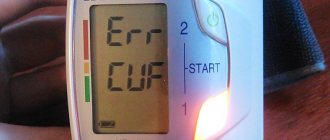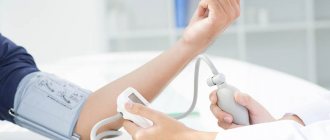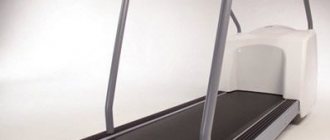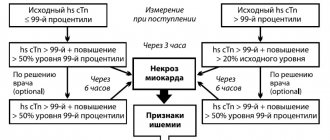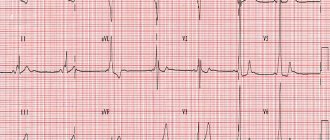Please note that the online store does not carry out verification of devices! An important criterion when choosing a tonometer, of course, is accuracy. After all, the idea of the general condition of the body depends on this important indicator. The answer to the question: “Which tonometer is the most accurate?” there will be a mercury tonometer. However, due to its large dimensions, its use at home is very problematic. Next come mechanical, automatic and semi-automatic blood pressure monitors. Many people believe that automatic blood pressure monitors are less accurate, but this is actually not the case. Modern automatic tonometers are developed using the latest technologies; the maximum measurement error can vary up to ±3 mm. rt. Art.
Verification and calibration of tonometers
First, it’s worth understanding the difference between “verifying” and “checking” a tonometer. Verification is a set of metrological operations to determine the accuracy of the device being tested. Tonometers for medical institutions should be checked once a year; for households, once every 3-5 years is sufficient. Verification of tonometers is carried out at regional centers for standardization, metrology and testing (TSM) , where a special apparatus is used to carry out the procedure, simulating a person’s blood pressure and pulse. The device is given certain parameters, which are compared with the measurement results of the tonometer being tested. If the verification is successfully completed, a corresponding certificate is issued, otherwise the device is sent for re-verification or to a service center, where the tonometers are calibrated. Addresses of service centers are indicated in the user manual.
It should be noted that before submitting your device for verification and further adjustment, make sure that you are using it correctly. The fact is that in most cases, incorrect tonometer readings are associated with its improper operation.
When is verification required?
Devices that measure blood pressure must be tested or calibrated. Typically, a new device is usually already configured and working fine. But sometimes a new device requires testing. This happens when the sphygmomanometer has been stored in a warehouse for a long time or has been exposed to sudden temperature changes.
It is necessary to check the operation of the device after frequent use or if it has not been used for a long time. Over time, both electronic and mechanical devices may malfunction.
How to check the accuracy of a tonometer at home yourself
What determines the accuracy of a tonometer?
Cuff fixation
The cuff must be put on in accordance with all the rules provided in the tonometer user manual. If this is not done, then at best the tonometer (automatic or semi-automatic) will produce a measurement error, and at worst – incorrect results, on the basis of which an incorrect idea of the current state of health will be formed. The cuff should be located 1-2 cm above the ulnar fossa and fit snugly to the skin.
Cuff size
The cuff must strictly fit in size, otherwise, if the cuff is small, the pressure measurement result will be overestimated, and if the size is too large, it will be underestimated. The width of the cuff should be 40% of the arm circumference.
Compliance with all rules for measuring blood pressure
The user manual, which is included with the tonometer, shows the rules for measuring blood pressure. It is necessary STRICTLY follow all the listed recommendations, as well as adhere to the basic tips when preparing for blood pressure measurement:
- No smoking for 30 minutes;
- Do not drink coffee, strong tea and alcoholic beverages;
- Rest 15-20 minutes before measuring.
Battery charge
Automatic and semi-automatic blood pressure monitors are powered by batteries, and some models have an adapter for mains operation. If the batteries are low, the tonometer may give an incorrect measurement result.
Breakage of bulb, cuff, pressure gauge, electronic unit
If any malfunctions are noticed, it is recommended to immediately contact the service center. Under no circumstances should you repair the tonometer yourself, especially if it is under warranty.
Step-by-step instruction
How to measure blood pressure correctly with a mechanical tonometer:
- Take a sitting position (a sofa or armchair is suitable for this).
- Lean your back on the back of the chair, and place your feet on the floor (it is not recommended to cross them, tuck them in, throw them on top of each other, etc.).
- The left hand is freed from clothing and placed on a table or any other flat surface. The main thing is that it is not in a canopy.
- Open the cuff, insert your hand into it and secure it slightly above (2-3 cm) the elbow bend.
- Place part of the stethoscope in the form of a small metal disk on the inside of your elbow. It is important that the pulsating artery is clearly felt in this place.
- If you are performing this procedure for the first time and do not yet fully understand how to correctly measure pressure with a mechanical tonometer, then first feel the pulse with your fingers. For the future, you will know exactly where to place the metal part of the stethoscope.
- Then insert the hearing aid stethoscope into your ears.
- Make sure the air release wheel on the bulb is tightly closed.
- Place the rubber bulb of the tonometer in your hand and begin manually supplying air. The arrow on the dial will begin to move. After it reaches the 200-220 mm mark. rt. Art., stop squeezing the bulb and slowly begin to spin the wheel. The air should come out slowly, about 4 mmHg. Art. per second.
- As the air descends, you should hear a pulse. The number where the needle will be on the first beat is your systolic pressure (i.e., top). The pulse will be heard for some time. The value at which the needle will be at the last beat is your diastolic blood pressure (i.e., lower).
- Measure blood pressure on the other arm. Consider higher values as reliable. In the future, measure the pressure on the arm where it is higher.
- Both results obtained must be written down or remembered.
In general, this process will take you a few minutes. This procedure must be carried out daily, recording the data obtained. Thus, you can determine the average values of your upper and lower pressure.
Tonometer test
To find out which tonometer is more accurate and also most convenient to use, let’s compare devices from popular manufacturers: Omron M1 Eco, Nissei WS-820, AND UA-777, Microlife BP A100, B.Well WA-55, Citizen CH-437C.
As a result of the tests, the tonometer from Omron took the leading position. The functionality of this device is complemented by the ability to calculate the average blood pressure value from the last 3 measurements taken within 10 minutes, which guarantees high accuracy of the result. Also, one of the advantages is the device’s memory - measurement results (with date and time registration) are saved even in the event of a power outage. It is important that if the blood pressure level is elevated, the tonometer gives an alarm in the form of a flashing icon on the display.
The measurement results are most clearly shown by the AND tonometer, using the World Health Organization blood pressure classification, which uses a color scale consisting of three colors indicating the blood pressure level: green - low, yellow - optimal, red - high. The cursor stops next to a specific color corresponding to the blood pressure level. A huge plus is also the fact that this is the only model among the tested tonometers that has control buttons labeled in Russian.
The largest cuff was found in B.Well and Microlife tonometers. The size of the cuff allows the procedure to measure blood pressure in people with a large arm circumference.
Diagnostic technique
You need to relax and be silent
How to correctly measure blood pressure with a mechanical tonometer? An inflatable cuff with a balloon is fixed on the shoulder at the site of pulsation of the brachial artery. The lower edge of the cuff should not reach the elbow (2 cm from it).
You must first free your hand from clothing. Initially, a palpation method of examining blood pressure is performed. Air is quickly inflated into the cuff to a level of 70 mmHg. Art. on the pressure gauge, then gradually increase the air pressure in the balloon by 10 mm until the pulse on the radial artery completely disappears. Then the air is gradually released until a pulse appears.
This method helps prevent overinflation of the cuff in the presence of the phenomenon of auscultation failure.
After the palpation method of recording pressure, the auscultatory method is carried out. To take measurements you will need the same thing and a phonendoscope.
The phonendoscope should be placed at the level of the ulnar fossa (a little higher and closer to the middle). Gradually pump air into the balloon so that the pressure in the cuff exceeds the pressure at which the pulse in the artery disappears by 20-30 mmHg. Then they open the valve a little and monitor the Korotkoff sounds and their changes.
- How to use a glucometer - instructions for use, rules of use, types and times for measurement
Principle of blood pressure measurement
For more than 100 years, the mechanical method of measuring blood pressure was considered the most effective and accurate. Its feature: recording the initial and final beats of the pulse in the blood vessel on which the tonometer cuff is placed. However, in this case, the accuracy of the readings was influenced by the personal factors of the person who took the measurements: extraneous noise, hearing problems, nervousness. As a rule, medical workers prefer to use a mechanical tonometer, considering them more accurate, which is not always true.
With the invention of automatic instruments, the oscillometric method began to be used, which makes it possible to correctly measure pressure regardless of the level of external noise and the condition of the person conducting the study. Pressure fluctuations (oscillations) are recorded automatically, converted into digital values and displayed.
How accurate are automatic devices?
As mentioned, every automatic blood pressure monitor has an error. Conscientious manufacturers indicate it on the packaging. Deviations are normal and do not indicate low quality of the tonometer if it does not exceed 10%.
The accuracy of electronic tonometers when measuring blood pressure is affected by compliance with the manufacturer's recommendations. Each certified device has instructions describing the procedure. The position of the cuff on the arm and the position of the limb (approximately at the level of the heart) are especially important.
How can I check the device?
Nowadays electronic devices are the most popular because they have an affordable price. They do not require special skills from the user to measure blood pressure. Even older people, women and teenagers can cope with it. They are easy to turn on and off once the test is complete.
But measurement accuracy plays a major role. Electronic and automatic devices often malfunction. For this reason, constant checking of the tonometer is necessary to avoid mistakes.
If your friends or neighbors have another device whose accuracy has been verified, you can use it to control accuracy and settings. The second such device will help you check the accuracy of your tonometer readings and identify errors in measurements.
Some are of the opinion that it is better to carry out measurements with mechanical instruments. But modern automatic devices perform their tasks perfectly. Some of the high-quality tonometers are devices from Omron.
The parallel connection method helps to evaluate each of the two devices and check the tonometers for accuracy.
For proper verification, follow the following algorithm:
- devices are connected in parallel for simultaneous measurements;
- double testing is carried out for objective assessment, control tests;
- If necessary, check individual parts of the device.
It is incredibly important for every person to monitor their own health. This is especially acute for older people. Many people keep blood pressure monitors at home, allowing them to measure blood pressure without going to the doctor. But how to check the tonometer if there is a suspicion of inaccuracy? This article will give advice on this matter.
